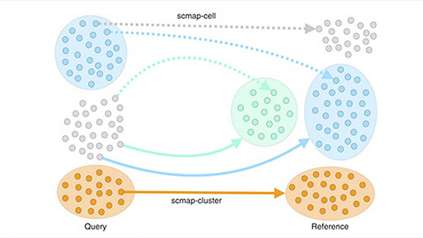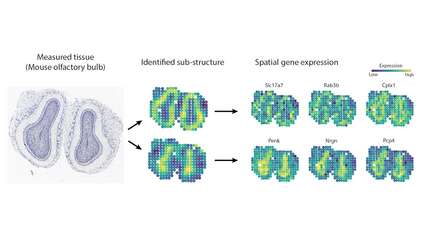First cell map of developing human liver reveals how blood and immune systems develop
In a world first, scientists have created the human developmental liver cell atlas that provides crucial insights into how the blood and immune systems develop in the foetus. It maps changes in the cellular landscape of the developing liver between the first and second trimesters of pregnancy, including how stem cells from the liver seed other tissues to support the high demand for oxygen needed for growth.
The atlas, published today (9 October 2019) in Nature, was created by researchers from the Wellcome Sanger Institute, Wellcome – MRC Cambridge Stem Cell Institute, Newcastle University, University of Cambridge and their collaborators. It is a comprehensive, high-resolution resource that improves our understanding of normal development and assists medical efforts to tackle diseases, such as leukaemia and immune disorders, which can form during development.
Until now, it was unknown precisely how the blood and immune systems develop in humans – a process known as haematopoiesis. As adults, it is bone marrow that creates our blood and immune cells. But in early embryonic life, the yolk sac and liver play a major role in making blood and immune cells. These cells subsequently seed peripheral tissues such as skin, kidney and finally bone marrow.
Scientists used single cell technology to analyse 140,000 liver cells and 74,000 skin, kidney and yolk sac cells. By isolating cells from the developing liver, they could identify them by what genes they were expressing and see what the cells looked like. Haematopoietic cells in sections of developmental liver were ‘tagged’ using heavy metal markers so researchers could map each cell to its location.
“Until now research in this area has been a little bit like blindfolded people studying an elephant, with each describing just a small part of it. This is the first time that anyone has described the whole picture, how the blood and immune systems develop in such detail. It’s been an extraordinary, multidisciplinary effort that is now available as a tool for the whole scientific community.”
Professor Muzlifah Haniffa A senior author of the study from Newcastle University and Senior Clinical Fellow at the Wellcome Sanger Institute
A developing foetus requires huge amounts of oxygen to fuel growth. The research discovered that during development, ‘mother’ haematopoietic stem cells stay in the liver. But as the liver alone cannot supply sufficient red blood cells, the next generation ‘daughter’ cells – known as progenitor cells – travel to other tissues. They mature in places such as the skin, where they develop into red blood cells to help meet the high demand for oxygen.
“We knew that as adults age our immune system changes. This study shows how the liver’s ability to make blood and immune cells changes in a very short space of time, even between seven and 17 weeks post-conception. If we can understand what makes the stem cells in the liver so good at making red blood cells, it will have important implications for regenerative medicine.”
Dr Elisa Laurenti A senior author from the Wellcome – MRC Cambridge Stem Cell Institute and the Department of Haematology at the University of Cambridge
Researchers also mapped genes known to be involved in immune deficiencies to see which cells were expressing them. Gene mutations can lead to immune disorders such as leukaemia, and it is hoped that by understanding how the healthy developing liver functions, it will be possible to understand how immune disorders arise and even how to treat them.
“The first comprehensive cellular map of the developmental liver is another milestone for the Human Cell Atlas initiative. The data is now freely available for anyone to use and will be a great resource to better understand healthy cellular development and disease-causing genetic mutations.”
Dr Sarah Teichmann A senior author from the Wellcome Sanger Institute, University of Cambridge and co-chair of the Human Cell Atlas Organising Committee
“Our immune system is vital in helping to protect us from disease, yet we know very little about how immune cells develop and behave in the early embryo. This study is hugely important, laying a critical foundation for future research that could help improve our understanding of disorders linked to the early immune system, such as childhood leukaemias. The Human Cell Atlas has the potential to transform our understanding of health and disease and we’re excited to see these first discoveries from our Wellcome-funded multidisciplinary team of scientists.”
Dr Katrina Gold Genetics and Molecular Sciences Portfolio Manager at Wellcome
More information
Publication
Funding:
This research was supported by the Wellcome Human Cell Atlas Strategic Science Support (WT211276/Z/18/Z), Wellcome (WT107931/Z/15/Z; WT206194; WT110104/Z/15/Z), The Lister Institute for Preventive Medicine, NIHR and Newcastle-Biomedical Research Centre, ERC Consolidator and EU MRG-Grammar awards, St Baldrick’s Foundation, Wellcome Sir Henry Dale and Royal Society Fellowships, European Haematology Association, MRC and BBSRC.
Publications:
Selected websites
Human Cell Atlas
Our mission is to create comprehensive reference maps of all human cells—the fundamental units of life—as a basis for both understanding human health and diagnosing, monitoring, and treating disease.
Wellcome - MRC Cambridge Stem Cell Institute
The Wellcome – MRC Cambridge Stem Cell Institute is a world-leading centre for stem cell research with a mission to transform human health through a deep understanding of normal and pathological stem cell behaviour. Bringing together biological, clinical and physical scientists operating across a range of tissue types and at multiple scales, we explore the commonalities and differences in stem cell biology in a cohesive and inter-disciplinary manner. In 2019, we relocated to a new purpose-built home on the Cambridge Biomedical Campus. Housing over 350 researchers, including a critical mass of clinician scientists, the Institute integrates with neighbouring disease-focused research institutes and also serves as a hub for the wider stem cell community in Cambridge.
About the University of Cambridge
The mission of the University of Cambridge is to contribute to society through the pursuit of education, learning and research at the highest international levels of excellence. To date, 107 affiliates of the University have won the Nobel Prize.
Founded in 1209, the University comprises 31 autonomous Colleges, which admit undergraduates and provide small-group tuition, and 150 departments, faculties and institutions. Cambridge is a global university. Its 19,000 student body includes 3,700 international students from 120 countries. Cambridge researchers collaborate with colleagues worldwide, and the University has established larger-scale partnerships in Asia, Africa and America.
The University sits at the heart of the ‘Cambridge cluster’, which employs 60,000 people and has in excess of £12 billion in turnover generated annually by the 4,700 knowledge-intensive firms in and around the city. The city publishes 341 patents per 100,000 residents.
Institute of Cellular Medicine, University of Newcastle
We carry out world-class research to advance understanding of disease and improve patient care. More than half of our academic staff are clinicians. We have close working relationships with a large cohort of patients and the Newcastle-upon-Tyne Hospitals NHS Foundation Trust.
About Newcastle University
Newcastle University, UK, is a thriving international community of some 27,750 students from over 130 countries worldwide. As a member of the Russell Group of research intensive universities in the UK, Newcastle has a world-class reputation for research excellence in the fields of medicine, science and engineering, social sciences and the humanities. Its academics are sharply focused on responding to the major challenges facing society today. Our research and teaching are world-leading in areas as diverse as health, culture, technology and the environment.
The Research Excellence Framework 2014 (REF) placed Newcastle University 16th in the UK for Research Power and the vast majority of our research (78%) was assessed to be world-leading or internationally excellent. Newcastle University is committed to providing our students with excellent, research-led teaching delivered by dedicated and passionate teachers. This is reaffirmed by achieving the best possible outcome – a Gold Award – in the Teaching Excellence Framework (TEF).
The Sanger Institute
The Wellcome Sanger Institute is a world leading genomics research centre. We undertake large-scale research that forms the foundations of knowledge in biology and medicine. We are open and collaborative; our data, results, tools and technologies are shared across the globe to advance science. Our ambition is vast – we take on projects that are not possible anywhere else. We use the power of genome sequencing to understand and harness the information in DNA. Funded by Wellcome, we have the freedom and support to push the boundaries of genomics. Our findings are used to improve health and to understand life on Earth.
About Wellcome
Wellcome exists to improve health by helping great ideas to thrive. We support researchers, we take on big health challenges, we campaign for better science, and we help everyone get involved with science and health research. We are a politically and financially independent foundation.





